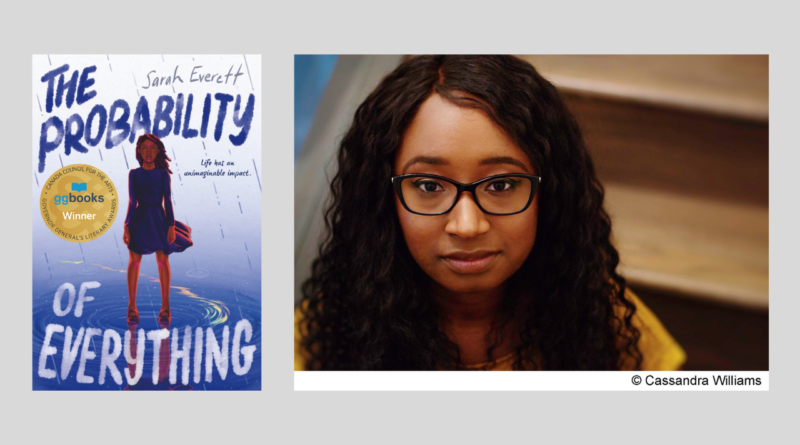Sarah Everett’s new novel The Probability of Everything is 100% engrossing and 100% unforgettable
Sarah Everett’s debut middle-grade novel The Probability of Everything (HarperCollins Canada, 2023) is a gem of a story – the kind you somehow know you should savour slowly . . . but you simply cannot put down. Delivering heartbreak, humour, hope and catharsis (not to mention an especially jawdropping twist), it has garnered widespread critical praise. And in November of 2023, The Probability of Everything was awarded Canada’s oldest and most prestigious recognition for literature: the Governor General’s Literary Award for Young People’s Literature. It comes with $25,000 for the Edmonton-based Everett, with another $3,000 going to her publisher for the book’s promotion.

The Probability of Everything deserves every praise it receives, and Everett should by rights be a household name. The book narrates the story of Kemi Carter, an 11-year old Nigerian American who lives with her parents and younger sister Lola (“Lo”) in a predominantly white neighborhood. An aspiring scientist with a passion for probability statistics, Kemi feels that her life is on the whole good, despite some friction with a racist neighbour. Her mother is expecting another baby, and Kemi is close to both her parents and her extended family.
Then the sudden threat of asteroid Amplus-68, which has an 84.7% chance of destroying Earth in four days, turns her routine life upside down. Staring down the apocalypse, she decides to create a time capsule containing the “most important stuff, the things we love most”, in order to safeguard her family’s memories after the asteroid hits. Kem is singleminded in her time-pressed pursuit of this project, but her relatives seem indifferent to it.
Everett’s narrative presents a compelling mix of raw grief, optimistic resilience and emotional depth – which are realized primarily in the determined and insightful character of Kemi. Everett began working on this book more than ten years ago, when she started to reflect on the aftermath of loss in her own younger years. She wanted to capture the disbelief and dissociation that underpin our responses to unexpected tragedy, and she views the book as an exploration of grief that is personal and individual, as well as systemic.
In addition to creating an engrossing, page-turning read, Everett’s particular skill is writing about the sobering topics of grief and the trauma of loss in a way that young readers can process. By presenting the situation entirely through young Kemi’s eyes, Everett captures how grief feels in a naturalistic way that is relatable and accessible for readers of all ages.
Although she is known for her young-adult novels (How to Live Without You, No One Here Is Lonely), The Probability of Everything will introduce her to a new demographic who will hail her as a Canadian treasure who deserves every accolade that she receives. In an in-depth conversation with SesayArts Magazine, Everett discusses the book’s protagonist and themes, describes how she explored the impact of grief through the eyes of a child and engages with some fun, quick-take questions.
SesayArts Magazine: In The Probability of Everything, you delve deeply into themes of grief and coping with tragedy through the eyes of a young protagonist, Kemi. What inspired you to explore these sobering topics in a middle-grade novel, and how did you balance them to make the story accessible and engaging for younger readers?
Sarah Everett: I think sometimes as adults we have these ideas about what topics are relevant to the lives of young readers. We might want those topics to be simple, straightforward, positive, easily digestible and any number of other things, but the reality is that kids live in the same world adults do. Topics like grief, family dynamics, racial tension – all those things are very much part of the complex world young readers navigate every day. A better way to think about it might simply be to accept that kids live in this incredibly difficult, complicated world (same as we do) and have to navigate it one way or the other. Books and stories in other forms can be tools that introduce these themes in ways that are more manageable and hopeful than what they might encounter in real life. Hopefully, books like mine give readers (and their parents!) the language and safe space to discuss some of the difficult themes, emotions and issues that they might face one day or that they might already be facing.
SesayArts Magazine: Racism is a significant challenge that Kemi’s family faces in their new predominantly white neighbourhood, Pineview. Could you discuss how you approached writing about this theme in a way that is both realistic and relatable for young readers? Additionally, how do these experiences shape Kemi’s character and the overall narrative?
Sarah Everett: For kids from communities of colour, there is no shielding them from race or racial issues, but I think age does sometimes give a little bit of distance to certain aspects of racial tension. You’re aware of some things (being the only Black kid in your school, for instance) to the extent that it involves you, but you can miss things you don’t know are important or catch things you also don’t know are important. There’s a lot of wondering, why is this person behaving this way to my family, or why did they say that thing they said? Are they mean or just grumpy or is something else going on? And for the things that you are aware of, it can still be difficult to grapple with the racial dynamics, especially when you don’t have much context around them.
When Kemi’s mother and aunt are arguing over whether Kemi and her family should be living in Pineview, Kemi doesn’t really take a position on it herself, because why should she have to? She doesn’t even really try to determine what is right or wrong or why her aunt might think this versus that. In certain ways, racial themes are peripheral or incidental to Kemi’s story — until they become central, which in many ways mirrors how kids first engage with issues of race before it personally impacts them.
SesayArts Magazine: The Probability of Everything seems to explore grief in a way that is both personal and individual as well as systemic. Can you elaborate a little about why you took this encompassing approach to the theme?

Sarah Everett: Wow, what a great question. There are so many ways I want to answer it! But I’ll start by saying that, for me, among the most complicated parts of grief are the ideas of personal loss and collective loss. To lose a loved one is such an intimate, raw, painful, individual experience, and you’re grieving the loss of that person as friend, brother, spouse, uncle, grandparent or whatever role they play in your life. But humans are multidimensional, so they fulfill multiple roles, and it can be just as tragic to realize that this person who is your friend is also, maybe, a great engineer and father and spouse or just a great human being – every individual loss is also communal, because the whole world loses them and everything they could have been.
Then, there’s also obviously the fact that grief hits in the most unexpected, benign, irrelevant ways or it can take the biggest, most profound, most debilitating form. You might cry at an old note left by a loved one or break down about the missing seat at the dining table from this point forward.
As a writer, I was trying to capture various things as far as the perspective and experience of grief. On one hand, The Probability of Everything is one girl’s story, one family’s story. On the other hand, everything is at stake. It is a catastrophic, life-altering, world-ending event. Both can be true at once, and grief has always felt to me like the one thing that has no true scale. It feels as big for you as it feels, whether that’s manageable or insurmountable.
SesayArts Magazine: Given that The Probability of Everything deals with serious themes and offers insights into dealing with the trauma of death and loss, what do you hope young readers will take away from Kemi’s journey?
Sarah Everett: I hope more than anything that the book sparks conversations between kids and other kids or the adults in their lives. I hope it helps kids express different emotions, and opens the door for questions and new ways of thinking and experiencing the world. I also hope kids engage with both the broad and small themes in the book. Like, what would you put in a time capsule? Or, have you ever felt out of place somewhere because of your race? Both are important, valid ways to approach the story.
SesayArts Magazine: And how did you protect your own emotional well-being while writing the book?
Sarah Everett: As for my emotional well-being, I made sure not to watch or read anything too heavy while I was drafting the book. Of course, the world was still on fire (as it tends to be!), but I limited the amount of news and social media I ingested. Other deliberate acts of self-care were important too, from getting massages to meditating to going to therapy to working out.
SesayArts Magazine: Which character is your favourite in The Probability of Everything and which character demanded the most of your attention as a writer?
Sarah Everett: My favourite character has to be Kemi, I think. It’s so obvious, but she’s the main character for a reason! 😊 I love her intelligence, her determination, her love for her family, her obsession with statistics and science.
The other side of the coin is that her character also then took the most fine tuning. My earliest drafts of the book suffered from Obviously Written By An Adult syndrome, in that I was very much writing my own reaction to an asteroid. I had to narrow in on not how I (or anybody) would react to an asteroid, but how this specific character would react to Amplus-68.
SesayArts Magazine: The Probability of Everything is an incredibly moving read that’s been awarded the Governor’s General Literary Award – so well (and obviously) deserved. Congratulations! How does this recognition feel to you?
Sarah Everett: Thank you! It’s so humbling when you look at the history of the awards (previous nominees and winners) and the nominees in my particular category. When you write a book that’s been on your mind for well over a decade, there’s a point where you start to feel like you just have to fling it off your chest so you can move on to the next thing. That being the case, The Probability of Everything could have been disastrous (during edits, I always start to wonder!) and could have been received as such. The story is special to me for personal reasons, but the generosity of readers (and, my goodness, the Canada Council) has been life changing and gratifying and so lovely. I don’t think I’ve fully processed it yet, but maybe it’s okay to always be a little in disbelief over this kind of recognition?
Quick Takes
1. What were your favourite books when you were a young reader? Did you see yourself represented in the books you read?
SE: I had so many favourites! But I think if you were to track the seeds of The Probability of Everything back into my formative years, it would lead to Charlotte’s Web.
Unfortunately, I did not see very many books featuring characters who looked like me when I was growing up. I was never confident enough or intentional enough to say, “hey, I want to change that!” but I do really hope that today’s STEM-loving Black girls are seeing more of themselves in books.
2. What authors or books are you reading right now that you would recommend, especially to your young readers?
SE: I love going back to tried and true authors, who luckily are still writing: Jason Reynolds, Rita Williams-Garcia, Jacqueline Woodson. More of my recent favourite reads have been by Janae Marks, Tae Keller, Renee Watson, Jasmine Warga, Mariko Tamaki and Chrystal D. Giles.
3. What is the best thing about being a writer, in your view?
SE: Getting to tell a story from start to finish is such a joy, and having people go along on the ride with me is a wonderful bonus. Those invisible points of connection between readers and writers – the feeling of “I’ve had this exact thought” or “I didn’t know other people felt like this too.” Experiencing that connection as a reader was a gamechanger, and as an author? It’s even better.
4. Tell us something about you outside of being a writer. Anything that might surprise us?
SE: Oh gosh! Well, I’m not sure this will come as a surprise to anyone, but (and I say this with the maximum amount of embarrassment) I am only just beginning to get the hang of hockey. It’s such a bad cliché – writers are bookish nerds who don’t watch sports. In this case, it’s partly true.
5. What question didn’t I ask you that you wish I had…and what is the answer?
SE: Well, I always love asking people what the last thing they read was! Mine was Tomorrow Tomorrow Tomorrow.

In-Conversation Author Event
HarperCollins Canada invites readers to meet Canadian literary icon Lawrence Hill and 2023 Governor General’s Award winner Sarah Everett! The award-winning authors will be chatting with FOLD Kids Book Fest coordinator Ardo Omer about their books for young readers: Beatrice and Croc Harry and The Probability of Everything. The event includes an audience Q&A, a book signing, snacks and a sneaky giveaway!
When: January 27, 2024
Where: Queen Books at 914 Queen Street East, Toronto
Tickets: The event is free and open to all. Register on eventbrite.ca.
© Arpita Ghosal, Sesayarts Magazine, 2024
About The Author
Arpita Ghosal
Arpita Ghosal is a Toronto-based arts writer. She founded Sesaya in 2004 and SesayArts Magazine in 2012.
Visit About Us > Meet the Team to read Arpita’s full bio …




